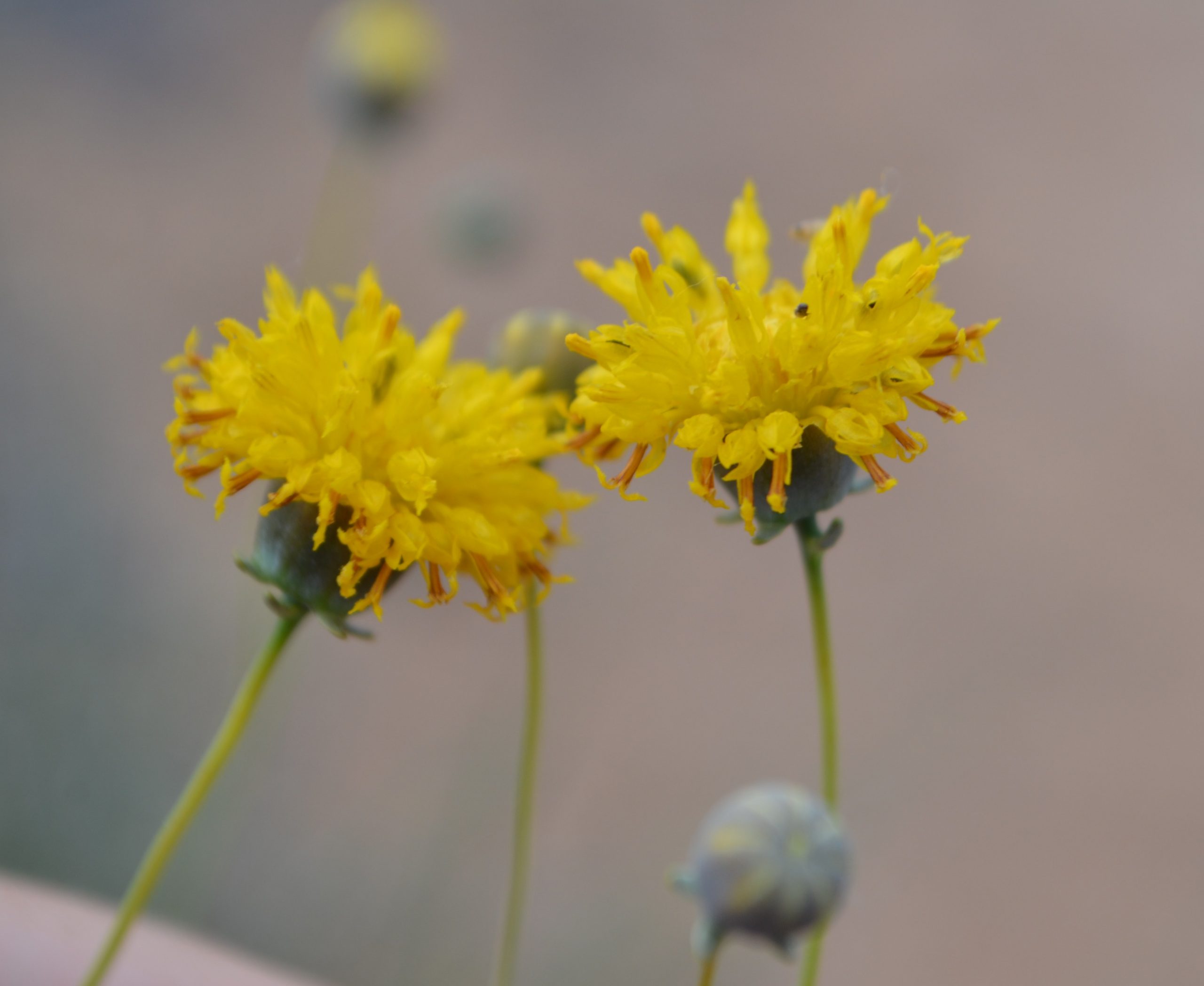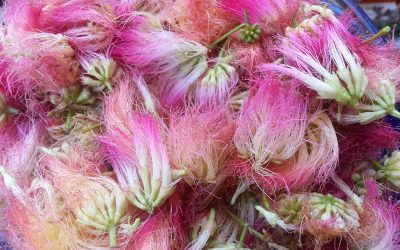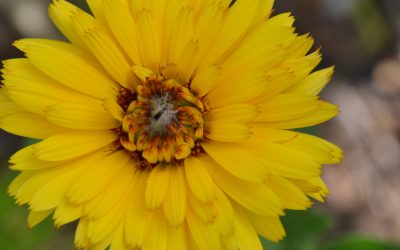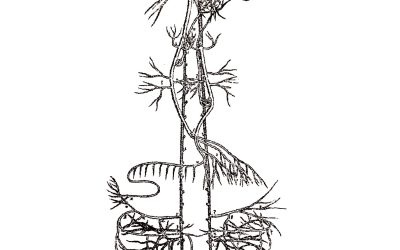Desert Mesa Medicine
by Dara Saville

The desert mesa is a landscape where we are confronted with the history of the land and the culture of people; a place where we cannot hide from ourselves. The endless vistas, open expanses, and clear blue skies put everything on display including our deepest vulnerabilities. Thought to be empty, hostile, ugly, or worthless the desert mesa is often overlooked and neglected. On the fringes of civilization, it is little visited except as a place to dump household waste, yard clippings, or worse. Take a walk with me, however, and feel the vitality pulsing through this unique place as we explore some of the plants that contribute to the character of this land. (To meet more desert plants, see my previous posts Desert Aromatics of the American Southwest and Herbal Tales from the Chihuahua Desert.)
Globemallow (Sphaeralcea spp.)
The captivating tiny orange flowers of our local Globemallows were one of the first wildflowers to ensnare my heart. Since then I have gotten to know many species blooming in varied colors and growing in a wide variety of environments, making it one of the most reliably abundant medicinal herbs in our area. The genus ranges across the Mountain West (primarily S. coccinea) but other species prefer the drier soils of the greater Southwest and Southern Great Plains. Due to their propensity for cross hybridizing, it can be very difficult to differentiate individual species. Globemallows have a close relationship with native desert bees, whose lives unfold in harmony with the coming of unpredictable rains that spur this plant’s seeds to germinate and summon the bees to gather nectar and pollinate Globemallow.
Globemallow has a long history of use in the Southwest and has been found regularly at archaeological sites including Chaco Canyon, where it is more frequently found in ceremonial kivas than residential or food prep rooms, suggesting ritual and/or medicinal usage. The continuum of this plant’s close relationship to humans carries over into historic Pueblos, Hispanic communities, and ot her modern herbal traditions where Globemallow is commonly called upon for a variety of health complaints including skin conditions, respiratory ailments, digestive issues, urinary inflammations, and hair care. As a cooling and demulcent anti-inflammatory that stimulates macrophage activity and promotes healing, Globemallow is useful whenever there is hot inflamed soft tissue. This includes chronic or poorly healing infections, dry coughs, sore throats, urinary infections, hemorrhoids, ulcers, splinters, abscesses, rashes, bites, and stings. Globemallow is also an effective tonic herb for immune system imbalances such as autoimmune conditions where it can help reduce inflammation and encourage effective immune functioning without over-exciting the system. This plant is prepared as a leaf tea (with or without flowers and strained through a cloth to catch potentially irritating tiny hairs), poultice, bath, or leaf and flower tincture prepared by preserving a strong tea with 25% alcohol. In addition to uses already described, Pueblo People have also pounded roots and mixed them with salt water as an infection or venom-drawing poultice or hard cast for broken bones and rubbed leaves on sore muscles for a rubifacient effect. Navajo consider Globemallow to be a Life Medicine and use roots to stop bleeding, treat skin ailments, indigestion, poor appetite, and coughs and colds. Navajo people also smoked dried leaves as tobacco and some tribes have also used Globemallow roots to make face paint or prepare pottery. Hispanic herb traditions include many of the same uses but also as a bath for babies with thrush or chronic diaper rash and a hair and scalp rinse made from mashed leaves and flowers.
her modern herbal traditions where Globemallow is commonly called upon for a variety of health complaints including skin conditions, respiratory ailments, digestive issues, urinary inflammations, and hair care. As a cooling and demulcent anti-inflammatory that stimulates macrophage activity and promotes healing, Globemallow is useful whenever there is hot inflamed soft tissue. This includes chronic or poorly healing infections, dry coughs, sore throats, urinary infections, hemorrhoids, ulcers, splinters, abscesses, rashes, bites, and stings. Globemallow is also an effective tonic herb for immune system imbalances such as autoimmune conditions where it can help reduce inflammation and encourage effective immune functioning without over-exciting the system. This plant is prepared as a leaf tea (with or without flowers and strained through a cloth to catch potentially irritating tiny hairs), poultice, bath, or leaf and flower tincture prepared by preserving a strong tea with 25% alcohol. In addition to uses already described, Pueblo People have also pounded roots and mixed them with salt water as an infection or venom-drawing poultice or hard cast for broken bones and rubbed leaves on sore muscles for a rubifacient effect. Navajo consider Globemallow to be a Life Medicine and use roots to stop bleeding, treat skin ailments, indigestion, poor appetite, and coughs and colds. Navajo people also smoked dried leaves as tobacco and some tribes have also used Globemallow roots to make face paint or prepare pottery. Hispanic herb traditions include many of the same uses but also as a bath for babies with thrush or chronic diaper rash and a hair and scalp rinse made from mashed leaves and flowers.
Datura (Datura wrightii)
There are few plants with more allure than the gorgeous and foreboding Datura. Prehistoric and historic usage of the plant highlights this duality as it is commonly found at ancestral Pueblo  archaeological sites dating back centuries but modern New Mexico Pueblos have no uses for the plant and often describe it with both attraction and fear. Although there are 20 species worldwide, most occur in the American Southwest and Mexico and favor dry areas with natural or human disturbance such as foothill drainages or urban areas from sea level up to 7,000 feet. Dunmire and Tierney (1995) theorize that Datura may have been brought up to the Southwest from Mexico as part of the exchange of ideas and goods and that Datura’s non-contiguous and spotty distribution and its association with sacred sites may be explained by its relationship to prehistoric cultures. Further supporting this theory is the local common name Toloache, derived from the Aztec name Toloatzin. A powerful and poisonous plant, Datura beckons both pollinators and herbalists with its offers of intoxication and transformation. Hawk moths, lured by the scent of night blooming flowers, descend into the depths of the tubular blossom in search of nectar. With wings beating against the corolla, they dust themselves with pollen and often fall to the ground or fly away erratically in search of their next intoxicating flower.
archaeological sites dating back centuries but modern New Mexico Pueblos have no uses for the plant and often describe it with both attraction and fear. Although there are 20 species worldwide, most occur in the American Southwest and Mexico and favor dry areas with natural or human disturbance such as foothill drainages or urban areas from sea level up to 7,000 feet. Dunmire and Tierney (1995) theorize that Datura may have been brought up to the Southwest from Mexico as part of the exchange of ideas and goods and that Datura’s non-contiguous and spotty distribution and its association with sacred sites may be explained by its relationship to prehistoric cultures. Further supporting this theory is the local common name Toloache, derived from the Aztec name Toloatzin. A powerful and poisonous plant, Datura beckons both pollinators and herbalists with its offers of intoxication and transformation. Hawk moths, lured by the scent of night blooming flowers, descend into the depths of the tubular blossom in search of nectar. With wings beating against the corolla, they dust themselves with pollen and often fall to the ground or fly away erratically in search of their next intoxicating flower.
Likewise humans have along history of seeking similar pain relieving or otherwise transforming experiences with Datura. The first recorded medicinal uses come from an ancient Babylonian tablet and include references to its poisonous, sedating, and aphrodisiac qualities. As a highly toxic plant, Datura teaches us caution and respect for the powers of the plant world. Furthermore, alkaloid proportions can vary between plants, increasing the danger of misuse and highlighting the importance of relationship with this plant. I have personally witnessed rashes develop from simply brushing bare skin against its leaves and Dunmire and Tierney noted that simply smelling a flower can make some nauseous or sedate children into drugged sleep. Consuming the plant can be fatal and there is no shortage of disturbing stories from people who have done so. One of the best such tales comes from Jamestown, Virginia where soldiers boiled and ate spring shoots (likely D. stramonium) with hallucinations and foolishness ensuing for 11 days before they returned to normal with no memory of the events. Clearly, Datura should not be consumed internally and is reserved for topical use or minor inhalations as emergency medicine. As a topical remedy, Datura leaves and flowers are one of our best analgesics and are commonly prepared as a bath, poultice, infused oil, or liniment. These can be helpful for wounds, headaches, cramps, achy muscles, sports injuries, arthritis, hemorrhoids, and hot inflamed skin conditions. I find Datura especially helpful when there is an emotional or psychological component to a person’s pain as this plant can be deeply transformative beyond the physical realm. A few inhalations of Datura, Mullein, and Salvia Sage smoke also makes a valuable emergency medicine for asthma constriction and severe allergic reactions as it relaxes bronchial spasms and reduces excess secretions (Moore, 2003). Common side effects of misuse include dry mouth and blurred vision or even death.
can make some nauseous or sedate children into drugged sleep. Consuming the plant can be fatal and there is no shortage of disturbing stories from people who have done so. One of the best such tales comes from Jamestown, Virginia where soldiers boiled and ate spring shoots (likely D. stramonium) with hallucinations and foolishness ensuing for 11 days before they returned to normal with no memory of the events. Clearly, Datura should not be consumed internally and is reserved for topical use or minor inhalations as emergency medicine. As a topical remedy, Datura leaves and flowers are one of our best analgesics and are commonly prepared as a bath, poultice, infused oil, or liniment. These can be helpful for wounds, headaches, cramps, achy muscles, sports injuries, arthritis, hemorrhoids, and hot inflamed skin conditions. I find Datura especially helpful when there is an emotional or psychological component to a person’s pain as this plant can be deeply transformative beyond the physical realm. A few inhalations of Datura, Mullein, and Salvia Sage smoke also makes a valuable emergency medicine for asthma constriction and severe allergic reactions as it relaxes bronchial spasms and reduces excess secretions (Moore, 2003). Common side effects of misuse include dry mouth and blurred vision or even death.
As previously mentioned, Native American relationships with this plant vary with some using the plant medicinally, others using it ceremonially, and some avoiding or fearing it. Uses are consistent with what has already been described but include additional ceremonial and medicinal knowledge, the details of which are largely unknown outside the respective cultural groups. Ethnobotanists have referred to Datura as “one of the most universally used hallucinogenic and medicinal plant known to man” (Bean & Saubel, 1972, p. 60). The Cahuilla, for example, smoked dried leaves to transcend worlds, have visions, encounter spirits, transform into other animals, diagnose illness, and give hunters increased power and connectivity to animals. Many other tribes have used Datura in similar ways including the Paiute, who ate seeds while gambling to guess the opponent’s hand, or the Zuni, who used it to see ghosts, empower rain priests to bring water, and enable victims to identify perpetrators in their dreams. Hopis used it to cure meanness and the Navajo ate fruits soaked and boiled and mixed with clay to neutralize toxicity.
Make Tea: Joint Fir (Ephedra torreyana), Cota (Thelasperma megapotamicum, T. gracile), and Indigobush (Dalea formosa)

Joint Fir, Mormon Tea (Ephedra torreyana)
There are lots of great tasting tea herbs out in the desert and Joint Fir, Cota, and Indigobush are just a few of them. Joint Fir, also known as Mormon Tea, is an unusual looking plant that is easy to recognize with its photosynthetic stems and cone-like structures. There are numerous species that range across the American West, with E. torreyana being the most common in our area. Gather the stems and use them to make a tasty tea for enjoyment of a wild beverage or as a medicinal preparation. Joint Fir is useful for respiratory conditions as a decongestant, increasing lung capacity, and also as a preventative for seasonal allergies. It is also included in formulas for the urinary system when an herb with diuretic, astringent, and anti-inflammatory action is needed. Also being high in calcium, Joint Fir can be added to nutritional teas for convalescence or as a preventative for osteoporosis. Dunmire and Tierney (1995) reported the Pueblo use of Joint Fir to quench thirst by chewing the stems. Lastly, it is worth mentioning that Southwest Ephedra species do not contain ephedra alkaloids, the stimulating chemicals associated with Chinese Ephedra.

Cota (Thelasperma megapotamicum, T. gracile)
Cota, also known as Greenthread or Hopi Tea, is a wiry little-noticed plant until its dainty yellow flowers appear. It is spread across much of the American West and Plains states and habits open sunny areas with moderately dry soil along roadsides, acequias, and semi-arid grasslands. Gather the stems with or without flowers, dry them in folded bundles, and use them like tea bags. This is a delicious tea with a wild taste and also serves as a mild medicinal. Acting as a gently purifying diuretic, it is often formulated for urinary system irritations, arthritis, and fevers. Cota, often combined with one of the mints, is also a traditional remedy for upset stomachs and blood purification.

Indigobush (Dalea formosa)
Indigobush, or Feather Dalea, is aptly named for its striking richly colored and feathery flowers. These fascinating flowers are color-changing, starting off with a yellow banner (the largest petal on a pea family flower) that changes to maroon after pollination, signaling other potential visitors that the nectar is already gone. This small woody shrub is frequently found on gravelly slopes in southern New Mexico and neighboring desert regions. Indigobush also makes a tasty sweet-scented tea that is made simply for wild refreshment but also has a local medicinal history. Traditional uses include bathing in the tea for arthritis relief, growing pains, and bodily pains as well as treating colds with feverish conditions.
blank
References
References:
Carolyn Dodson, A Guide to Plants of the Northern Chihuahua Desert, (Albuquerque, NM: University of New Mexico Press, 2012).
Charles Kane, Medicinal Plants of the American Southwest, (Lincoln Town Press, 2011).
Daniel E. Moerman, Native American Ethnobotany, (Portland, OR: Timber Press, 1998).
Lowell John Bean and Katherine Siva Saubel, Tempalpakh (From the Earth): Cahuilla Indian Knowledge and Usage of Plants, (Banning, CA: Malki Museum Press, 1972).
L. S. M. Curtin, Healing Herbs of the Upper Rio Grande, (Los Angeles, CA: Southwest Museum, 1965).
Michael Moore, Medicinal Plants of the Desert and Canyon West, (Santa Fe, NM: Museum of New Mexico Press, 1989).
Michael Moore, Los Remedios, (Santa Fe, NM: Museum of New Mexico Press, 1990).
Michael Moore, Medicinal Plants of the Mountain West, (Santa Fe, NM: Museum of New Mexico Press, 2003).
William W. Dunmire and Gail D. Tierney, Wild Plants of the Pueblo Province, (Santa Fe, NM: Museum of New Mexico Press, 1995).
William W. Dunmire and Gail D. Tierney, Wild Plants and Native Peoples of the Four Corners, (Santa Fe, NM: Museum of New Mexico Press, 1997).



